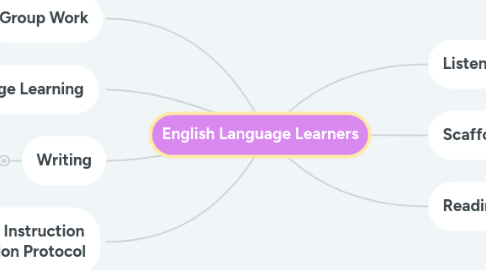
1. Listening
1.1. Two-way listening tends to be easier for an EL learner since they are actively engaged in conversation with another. They are able to ask questions or clarify meaning if needed.
1.2. Background noise can interfere with a student's ability to listen effectively.
1.3. Effective listening involves comprehension and drawing meaning to what is being said.
1.4. Listeners rely on their in-the-head knowledge to make connections to new information.
1.5. The teacher should model effective listening by asking for clarification or repeating what the speaker said. This teaches students how to do the same when they are unsure of the message.
2. Scaffolding
2.1. Based on the work of Lev Vygotsky, the zone of proximal development is the cogitative gap between what a child can do unaided and what they can do jointly with a more skilled expert. By working in coordination with another, the students it able to reach beyond what they could do alone (Gibbons pg.13)
2.2. Scaffolding provides temporary assistance to the students. With this support, they can work beyond their current knowledge and acquire the skills necessary to complete the same tasks alone in the future.
2.3. By provide a high challenge, high support learning environment, students are supported and challenged appropriately.
3. Group Work
3.1. Students tend to feel more comfortable working with peers in a small group setting.
3.2. The opportunities for interaction are increased which provides further language learning.
3.3. Students learn how to work together. Each individual is responsible for their own role.
3.4. Joint construction allows students to scaffold one another to make the message understood. The language becomes more refined and explicit.
3.5. The teacher should ensure that talk is necessary to complete the task. Each member knows or needs to acquire specific information to complete the task as a whole.
4. Language Learning
4.1. El learners should be viewed as capable and intelligent learners. With the right support and guidance, they are able to achieve just as their English-speaking peers.
4.2. Academic language is explicit and tends to be more difficult for EL learners. It can take up to seven years to be considered proficient. However, by utilizing prior knowledge and hands-on activities, students can become understood more quickly.
4.3. Social language is picked up and used quickly; typically within a year or two. This language is more meaningful and used more often among peers.
5. Writing
5.1. The mode continuum is the process of moving from spoken language to writing explicit, academic text.
5.2. Literate talk serves as the language bridge between talking about the activity and writing about it in academic context (Gibbons, pg 83).
5.3. Teacher guided reporting introduces and makes understood the academic language needed to explain students' understanding. When a student reports their learning, the teacher carefully molds it into academic context which can be applied in written form.
6. Reading
6.1. Being able to read in their first language is an important factor when learning to read in English. Through meaningful reading opportunities, students are provided more exposure to the language which paves the way for fluency.
6.2. Being an effective reader includes semantic knowledge (world or specific topic), syntactic knowledge (structure of language), and graphophonic knowledge ( sounds, letters, and phonemic patterns in English). Without these, students may resort to sounding out the words which distracts the comprehension of the text.
6.3. The reading roles as a code breaker, text participant, text user, and text analyst emphasize particular aspects of literacies. When students are able to take on these roles, they are more successful on their reading journey
6.3.1. code breaker: distinguish the sounds of English, left-to-right directionality, and alphabet knowledge.
6.3.2. text participant: connects the text with prior knowledge
6.3.3. text user: participation in the social activities in a range of social contexts
6.3.4. text analyst: is able to read critically and understands the author's message
6.4. Planning for Reading
6.4.1. Before reading activities are important to prepare the reader for the upcoming text. It gives them the skills and resources to draw on when reading through the content.
6.4.2. During reading activities engage readers with the text and make explicit what it expected from an effective reader.
6.4.3. After reading activities allow the student to focus on the newly learned content. It provides the opportunity to apply learning to other studies.
